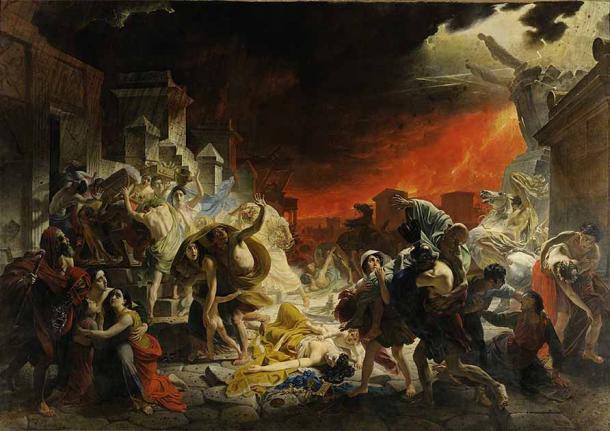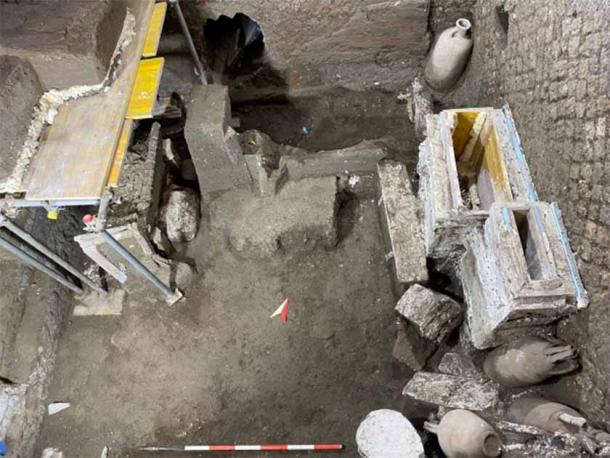
Excavations at Pompeii Villa Unearth Room Used by Roman Slaves
During excavations at the Civita Giuliana villa in a suburb of the doomed ancient city of Pompeii in southern Italy, archaeologists unearthed a small, cramped room that told a story of misery and deprivation. Two beds had been stuffed into this tiny space, but only one mattress had been supplied, highlighting how difficult life was for the Roman slaves who had occupied these constricted quarters 2,000 years ago, before Pompeii was destroyed by a volcanic eruption in 79 AD.
In addition to the unmistakable outlines of the two beds, archaeologists also found two small cabinets, several urns and ceramic containers. Inside three of the containers they found the remains of two mice and a rat, suggesting the Roman slaves who occupied this claustrophobic space were forced to live in conditions that were unsanitary as well as unpleasant.
- Archaeologists Excavating In Pompeii Find Ancestral Pizza Revealed in Fresco
- Intimate Secrets: Pompeii's Forbidden Erotica Exposed (Video)
“These details once again underline the conditions of precarity and poor hygiene in which the lower echelons of society lived during that time,” announced the Italian Ministry of Culture in The Guardian.

The eruption ensured the preservation of certain details which would otherwise have been lost to time, such as the bedding used within the Roman slave quarters. (Ministero della Cultura)
Learning More About the Lives of Roman Slaves
The Civita Giuliana villa was discovered in a wealthy suburb located approximately 2,000 feet (600 meters) north of the city of Pompeii early in the 20th century. In 2017, the Archaeological Park of Pompeii launched a new round of excavations at the heavily explored site, and these modern explorations have uncovered many relics that reveal details about Roman society and culture in the first century AD.
Among the more notable finds are a ceremonial chariot and a stable, the latter of which contained the preserved remains of three horses wearing harnesses they would have used to pull the chariot. But while discoveries like these shed light on elite lifestyles in ancient Pompeii, the newly excavated room reveals how the other half lived.
Surprisingly, the archaeologists who excavated the slave quarters in the villa found no signs of any restraints that might have been used to restrict the movements of the room’s occupants. There were no locks, chains or grates for added security, suggesting that Roman slaves in ancient Pompeii were resigned to their fates.
“It seems that control was primarily exerted through the internal organization of servitude, rather than physical barriers and restraints,” Gabriel Zuchtriegel, the director of the Archaeological Park of Pompeii, told Reuters.
While this new find is enlightening, it is not unique. In 2021, archaeologists working for the Archaeological Park unearthed another small and oppressive room at Civita Giuliana that they quickly identified as having belonged to slaves. This room had been supplied with three cots, despite really only being big enough to comfortably house one person.

Pompeii is a fascinating archaeological site because the dramatic events of the eruption of Mount Vesuvius have provided a time capsule filled with information about life in Pompeii. The Last Day of Pompeii by Karl Brullov. (Public domain)
The Truth about Roman Society Perfectly Preserved at Pompeii
Pompeii is famous in history for having been destroyed in a massive eruption of Mount Vesuvius, continental Europe’s only active volcano, in the year 79 AD. This incredibly violent event produced a massive cloud of volcanic ash and rock that buried the city completely, killing thousands of Roman citizens who were unable to escape nature’s fury.
Over time, the cloud of volcanic material that settled over the city cooled, hardened and turned to soil. Organic materials trapped inside and underneath the soil gradually decayed away, leaving behind empty cavities found by archaeologists performing excavations.
They discovered that by filling these cavities with plaster it was possible to make casts of the items that had once been there. This is exactly the procedure used to identify the items that had been in the cramped Roman slave quarters when the city was destroyed 1,944 years ago.
Using this reliable method of reconstruction, archaeologists have found some other remarkable things at Civita Giuliana. One of the most haunting discoveries took place in 2020, when excavations unearthed body-sized cavities that had once held the remains of two individuals who’d been killed during the great volcanic eruption.

Reconstruction work taking place at the site of the Roman slave room in Pompeii. (Ministero della Cultura)
When the plaster was poured, it produced two lifelike recreations of bodies that lay sprawled on the floor of a room where they had apparently hid attempting to escape from the fiery volcanic rain. Their efforts proved to be in vain.
- Lavish Home of Two Former Slaves Opened Up to the Public in Pompeii
- Bedroom Furnishings Offer a Glimpse of Middle-Class Life in Pompeii
Archaeologists identified one of the two men as a wealthy Roman elite between the ages of 30 and 40 (he was wearing a tunic that revealed his status). The other body belonged to a younger man between the ages of 18 and 23, who archaeologists concluded was a manual laborer or a slave, based on the compressed vertebrae in his back that suggested he had done a lot of heavy lifting.
All of these findings reveal the truth about who lived in Pompeii at the time of its annihilation, and about what their lives were really like. “What we are learning about the material conditions and social organization of that era opens up new horizons for historical and archaeological studies,” said Gennaro Sangiuliano, the Italian Culture Minister, in reference to the discoveries at Civita Giuliana.
The devastating destruction of Pompeii created a uniquely well-preserved archaeological site. Findings such as the most recent Roman slave quarters that show how the privileged and the underprivileged lived during the Roman Empire’s heyday.
Top image: Excavations at the Civita Giuliana villa reveal life in Roman slave quarters at time of eruption. Source: Ministero della Cultura
By Nathan Falde















